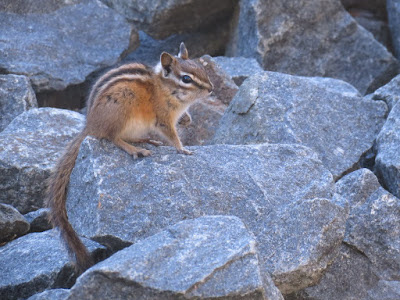These classifications are based on seeing animals live and unrestrained. Bats are mostly identifiable with a bat detector, and trapping allows views of various small mammals, but I'm discounting those methods below. I've also arbitrarily excluded feral cats and pigs as well as humans from this list. Species I've seen are marked with an asterisk.
Moose
Easy - These species should be essentially guaranteed if you spend a reasonable amount of time in the large areas where they're common
- Least Chipmunk*
- Eastern Grey Squirrel*
- Eastern Chipmunk*
- Red Squirrel*
- Groundhog*
- Beaver*
- Meadow Vole*
- Muskrat*
- White-footed Mouse/Deer Mouse* (Inseparable in any realistic field setting? There are differences that are visible from some distance, but from what I've read they may not be entirely reliable. Only Deer Mouse is found north of about North Bay. Getting White-footed Mouse seems like a real challenge.)
- Porcupine*
- Snowshoe Hare*
- Eastern Cottontail*
- Short-tailed Shrew*
- Eastern Coyote*
- Red Fox*
- Mink*
- Striped Skunk*
- Raccoon*
- Black Bear*
- Moose*
- White-tailed Deer*
Least Chipmunk
- Virginia Opposum* (common but highly nocturnal)
- Northern Flying Squirrel
- Southern Flying Squirrel* (Flying squirrels are very difficult to identify in the broad area of range overlap, which to my knowledge is approximately Hamilton to North Bay)
- Franklin's Ground Squirrel (Rainy River, I'm not sure how common it is there)
- Fox Squirrel* (Pelee Island)
- Woodland Jumping Mouse*
- Meadow Jumping Mouse*
- Southern Red-backed Vole*
- House Mouse*
- Norway Rat*
- European Hare* (declining, probably most common in extreme Southwestern Ontario now)
- Eastern Red Bat*
- Silver-haired Bat
- Hoary Bat*
- Big Brown Bat* (These four bats are a little more distinctive than the four species listed below, and the first three are seen relatively frequently as migrants)
- Eastern (Algonquin) Wolf* (mostly Algonquin Park)
- Grey Wolf
- Grey Fox (mostly Pelee Island)
- Arctic Fox (not sure how common these are in their very difficult to access range, might belong in the Easy category)
- Canada Lynx
- River Otter*
- American Marten* (common and easily seen in Algonquin, but my understanding is that they're a lot less common in most other areas with much human settlement)
- Fisher*
- Short-tailed Weasel (Ermine)*
- Long-tailed Weasel*
- Elk (introduced populations mostly in Bancroft area)
- Woodland Caribou (easy on the Slate Islands, otherwise difficult)
- White-tailed Jackrabbit (Rainy River, and very rare there?)
- Water Shrew
- Eastern Mole (Point Pelee)
- Hairy-tailed Mole*
- Star-nosed Mole
- Eastern Small-footed Myotis
- Little Brown Myotis*
- Northern Myotis
- Tricolored Bat (these four bats are in major decline due to white-nose syndrome, and regardless are not possible to identify without a bat detector or by finding them roosting. Formerly a lot more common and easily seen, but likely to be almost completely eliminated from Ontario in the near future.)
- Bobcat
- American Badger
- Rock Vole
- Woodland Vole
- Heather Vole
- Northern Bog Lemming
- Southern Bog Lemming (perhaps a bit easier than the rest on this list)
- Arctic Shrew
- Masked Shrew
- Smoky Shrew
- Pygmy Shrew (These four Sorex shrews are common sightings as a whole, and I've seen likely over 50 individuals, but separating the species them is generally not possible as far as I know).
Sorex sp.
Good luck, you'll need it.
- Wolverine
- Cougar
- Least Shrew
- Least Weasel (maybe this is actually possible in some areas?)
- Harbour Seal
- Ringed Seal
- Bearded Seal
- Walrus
- Polar Bear
- Beluga
- Narwhal
And that's it except for a few species that have been recorded but are likely not present with any regularity (Thirteen-lined Ground Squirrel, Black Rat, Arctic Hare, Vesper Bat, Minke Whale). I've seen about 42/80 species.
Snowshoe Hare




